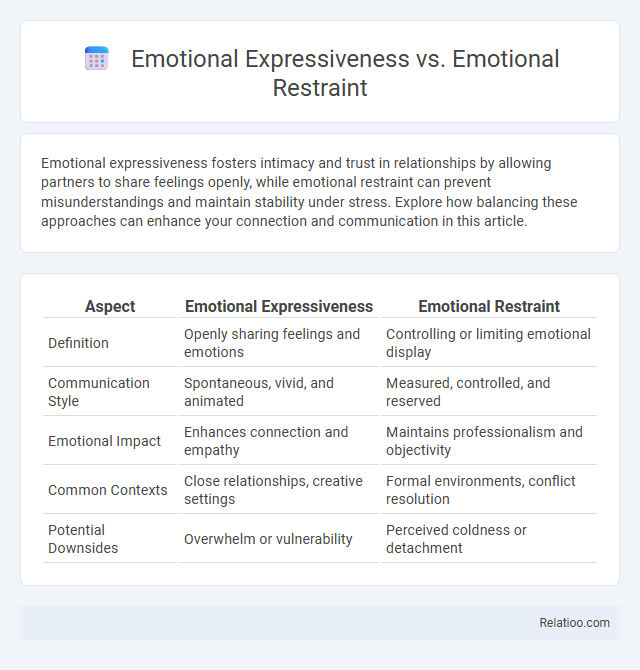Emotional expressiveness fosters intimacy and trust in relationships by allowing partners to share feelings openly, while emotional restraint can prevent misunderstandings and maintain stability under stress. Explore how balancing these approaches can enhance your connection and communication in this article.
Table of Comparison
| Aspect | Emotional Expressiveness | Emotional Restraint |
|---|---|---|
| Definition | Openly sharing feelings and emotions | Controlling or limiting emotional display |
| Communication Style | Spontaneous, vivid, and animated | Measured, controlled, and reserved |
| Emotional Impact | Enhances connection and empathy | Maintains professionalism and objectivity |
| Common Contexts | Close relationships, creative settings | Formal environments, conflict resolution |
| Potential Downsides | Overwhelm or vulnerability | Perceived coldness or detachment |
Introduction to Emotional Expressiveness and Restraint
Emotional expressiveness involves openly sharing feelings through facial expressions, tone, and body language, while emotional restraint emphasizes controlling or suppressing these outward displays. Gender dynamics play a significant role, as societal norms often encourage women to be more emotionally expressive and men to adopt restraint, influencing interpersonal communication and emotional well-being. Understanding these patterns helps You navigate social interactions and foster more authentic connections.
Defining Emotional Expressiveness
Emotional expressiveness refers to the extent and manner in which individuals openly display their emotions through facial expressions, verbal communication, and body language. Research consistently shows that women tend to exhibit higher emotional expressiveness compared to men, influenced by socialization patterns and cultural expectations tied to gender roles. Understanding gender dynamics in emotional expressiveness is crucial for recognizing how societal norms shape the way emotions are communicated and interpreted across different contexts.
Understanding Emotional Restraint
Emotional restraint varies significantly across gender dynamics, often shaped by cultural norms that encourage men to suppress emotions while permitting women more emotional expressiveness. Understanding emotional restraint involves recognizing its function as a coping mechanism to maintain social harmony and professional composure, especially prevalent in male socialization. Research shows that excessive emotional restraint can impact mental health, increasing risks of stress-related disorders and reducing interpersonal intimacy.
Cultural Perspectives on Emotional Expression
Cultural perspectives on emotional expression reveal that emotional expressiveness and restraint vary significantly across societies, often influenced by gender norms that prescribe acceptable emotional behaviors for men and women. In many collectivist cultures, emotional restraint is valued to maintain social harmony, while individualistic cultures encourage emotional expressiveness as a sign of authenticity and personal freedom. Gender dynamics play a crucial role, with women frequently expected to display nurturing emotions openly, whereas men may be socially conditioned to suppress vulnerability, reflecting deep-rooted cultural beliefs about masculinity and femininity.
Psychological Impacts of Expressiveness
Emotional expressiveness significantly influences psychological well-being by fostering authenticity, enhancing interpersonal connections, and reducing stress-related symptoms. In contrast, emotional restraint, often shaped by gender norms, can lead to internalized distress, increased anxiety, and impaired emotional regulation. Gender dynamics play a crucial role in shaping these patterns, with societal expectations frequently encouraging expressiveness in women while promoting restraint in men, thereby affecting mental health outcomes differently across genders.
Effects of Emotional Restraint on Well-being
Emotional restraint impacts well-being by often increasing stress levels and hindering authentic self-expression, leading to potential anxiety and depression. Men, influenced by traditional gender dynamics, are more likely to adopt emotional restraint, which can exacerbate feelings of isolation and reduce social support. Understanding how your emotional expression aligns with these gender norms can improve mental health outcomes and enhance interpersonal relationships.
Emotional Expression in Relationships
Emotional expressiveness in relationships often varies significantly across gender lines, with studies showing women typically exhibit higher levels of emotional communication and empathy, fostering intimacy and conflict resolution. Emotional restraint, more commonly observed in men, can be influenced by societal norms promoting stoicism, potentially leading to communication gaps and misunderstandings in partner interactions. Understanding these gendered emotional dynamics is crucial for enhancing emotional connection, trust, and satisfaction within relationships.
Navigating Emotional Balance in the Workplace
Navigating emotional balance in the workplace requires understanding the interplay between emotional expressiveness and emotional restraint within the context of gender dynamics. Women often face expectations to display empathy and express emotions, while men may experience pressure to maintain emotional control, influencing communication styles and leadership perceptions. Your ability to recognize these nuanced gendered norms can enhance workplace relationships and foster a more inclusive, emotionally intelligent environment.
Strategies for Healthy Emotional Regulation
Strategies for healthy emotional regulation involve recognizing how cultural norms around gender influence emotional expressiveness and restraint, shaping how emotions are managed and communicated. You can develop emotional intelligence by balancing authentic expression with appropriate emotional control, using techniques such as mindfulness, cognitive reappraisal, and active listening. Embracing these strategies promotes psychological well-being and improves interpersonal relationships across diverse gender dynamics.
Choosing Between Expressiveness and Restraint
Choosing between emotional expressiveness and restraint involves understanding how gender dynamics shape societal expectations and personal experiences. Research shows women are often encouraged to display emotions openly, while men face pressure to maintain stoicism, impacting emotional communication and relationships. You can navigate these dynamics by balancing authentic emotional expression with situational restraint to foster healthier interactions and personal well-being.

Infographic: Emotional Expressiveness vs Emotional Restraint
 relatioo.com
relatioo.com